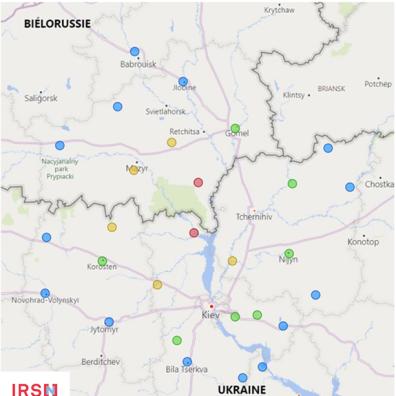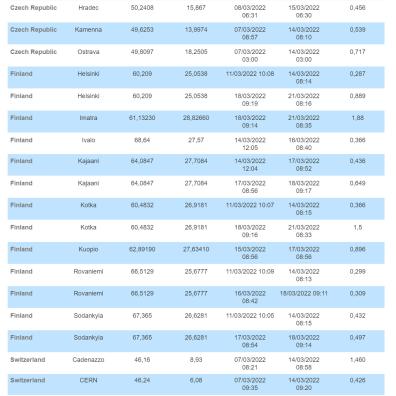Ukraine: Report on fires in the Chernobyl exclusion zone
Current situation
In a press release on 21 March 2022, the Ukrainian safety authority SNRIU indicated that forest fires had been burning in the Chernobyl exclusion zone since 11 March, mainly in the central and west areas of the exclusion zone created after the accident in 1986. The IAEA was also informed by SNRIU (cf. Update 30 – IAEA Director General Statement on Situation in Ukraine).
Experience feedback
Large-scale fires occur every year in Russia, Belarus and Ukraine. Some of these fires affect the areas contaminated by the Chernobyl accident. During such events, air masses can absorb radioactivity and move towards Western Europe and France, as was the case in 2002, 2010 and 2020, for example.
Since the Chernobyl accident, tree trunks/branches and litter (layer of leaves which fall year after year) in the contaminated areas of Belarus, Ukraine and Russia tend to store the radionuclides initially deposited on the ground and absorbed by roots. If such matter is burned, these radionuclides can be partially released in the smoke and hence contaminate the air. This is particularly true for caesium 137, the main radionuclide dispersed in Europe during the Chernobyl accident and still detectable today.
It is important to take note that these events have led, to date, to very low-level ambient activity, which cannot be measured in France other than using the air sampling stations of the IRSN OPERA-Air network. Measurements are taken for the filters in this network using high-performance laboratory techniques and detect very small amounts of radioactivity. During the episode in April 2020, only nine measurements taken at these samplers in France could be considered as in excess of usual background levels (approx. 0.1 µBq/m3 in France), with very low levels nonetheless, of between 0.51 ± 0.20 µBq/m3 of air (Fessenheim) and 1.31 ± 0.24 µBq/m3 of air (Cadarache). Other European countries and Ukraine also detected the impact of fires during this event. In the Chernobyl exclusion zone, activity levels occasionally reached several mBq/m3 of caesium 137.
Available data on 24 March 2022
Equivalent Dose Rate (EDR) monitoring stations in the exclusion zone, managed by Ecocentre, a Ukrainian government-operated firm, and stations near to the Chernobyl reactors (including reactor n°4 damaged in 1986) managed by the site operator, ceased operation in late February 2022 due to the current conflict. On this basis, these stations are no longer providing data on radioactivity in the zone.
The Ukrainian national network station, located in the town of Chernobyl, is still transmitting data, but intermittently, due to power supply problems in the area. Up to 18 March, the last date on which this station transmitted the mean hourly EDR over a 24-hour period, radioactivity was not abnormally high.
The following map shows the stations of the Belarus and Ukrainian national networks, which transmit data to the European EURDEP system (mean EDR over 24h), in a 200 km radius around the Pripyat site. None of these stations have indicated a significant increase in EDR over the 11 - 18 March period, and local fluctuations were systematically less than 50 nSv/h.

SNRIU also informed the IAEA that very slight increases in airborne caesium-137 levels had been detected in Kiev and by radiological monitoring at the Rovno NPP and Khmelnitsky NPP in the west of the country, but that these detections did not pose a radiological problem.
In addition, aerosol filter measurements from other European countries currently available in the EURDEP system do not indicate any significant increase in caesium 137 ambient activity levels (see table below). Filters of IRSN's national OPERA-Air network for the period in question are analyzed as they are received.
Results of aerosol filter measurements in European countries: Caesium-137 activity levels in air

